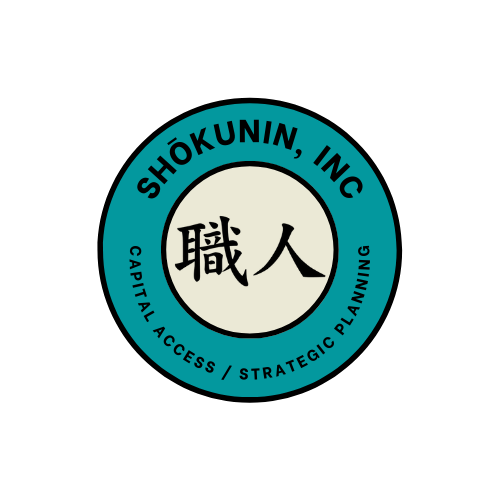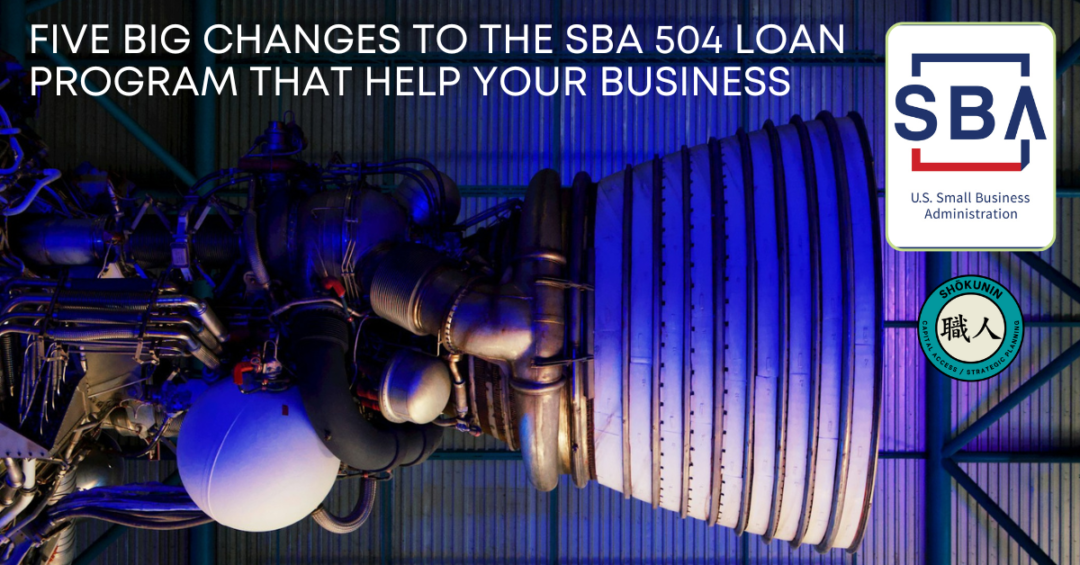The Small Business Administration (SBA) has announced significant changes to the SBA 504 Debt Refinance Program. They will be effective November 15, 2024. These changes are designed to help small business owners refinance debt more easily and access additional capital, which is particularly beneficial for industries that require significant upfront investments and face long cash flow cycles. In this article, we’ll explore the key updates to the program and their implications and use a real-world example from the aerospace sector to illustrate their potential impact.
Overview of SBA 504 Debt Refinance Program Changes
The SBA 504 Debt Refinance Program is a long-term, fixed-rate financing tool used by small businesses to refinance existing debts related to real estate or heavy equipment. The recent modifications to the program will make it more versatile and accessible, providing much-needed relief for small businesses struggling with liquidity and cash flow management.
Below are the key changes being implemented:
- Increased Loan-to-Value Ratio
- Removal of Expense Caps
- Inclusion of Other Secured Debt
- Revised Substantial Benefit Test
- Expanded Eligibility for Refinancing
Increased Loan-to-Value Ratio
Previously, businesses refinancing debt under the SBA 504 program had to maintain an 85% loan-to-value (LTV) ratio. As of November 15, 2024, this requirement will be increased to 90%. This change allows businesses to finance a greater portion of their real estate or equipment, freeing up capital that can be used for other needs. This increase in LTV is particularly beneficial for owner-user businesses in capital-intensive sectors like aerospace, where assets are often costly and difficult to liquidate.
Removal of Expense Caps
Another significant change is the elimination of the cap on cash-out for eligible business expenses, previously set at 20% of collateral value. Under the new rule, there is no cap if the funds are used for operating expenses rather than capital expenditures. This flexibility is crucial for businesses that need to cover long operating cycles or unexpected cost increases without being overly restricted by cash-out limits.
Inclusion of Other Secured Debt
The updated guidelines allow businesses to include other secured debts when refinancing, provided the same commercial real estate or equipment secures them. This provision means companies with complex financing structures, such as multiple loans on a single property, can consolidate these obligations into a single SBA 504 loan, reducing the administrative burden and streamlining payments.
Revised Substantial Benefit Test
The substantial benefit test has been revised to ensure that any new installment amount attributable to the refinanced debt must be less than the existing installment amount. This ensures that refinancing provides an actual financial benefit, lowering monthly debt payments and improving cash flow. By decreasing the financial burden, the revised test aligns with SBA’s goal of helping businesses remain competitive while managing debt efficiently.
Expanded Eligibility for Refinance
The eligibility for refinancing has also been broadened. Debt is now eligible for refinancing if at least 75% of the original use of proceeds was for SBA 504-qualified purposes. This expanded eligibility includes a range of loans, such as conventional loans, SBA 7(a) loans, private loans, hard money loans, and USDA loans. By expanding eligibility, the SBA is opening the door for more businesses, particularly those who have relied on different forms of debt, to restructure and benefit from favorable SBA loan terms.
Real-Life Example: An Owner-User Business in the Aerospace Industry
Aerospace Company Profile
Imagine an aerospace parts manufacturer, AeroTech Components, based in California. AeroTech supplies high-precision components for government contracts and commercial clients, including major airlines and aerospace partners. Their business model is owner-user—they own their manufacturing facility and machinery. Like many companies in this industry, AeroTech faces unique challenges:
- Long Lead Times for Inventory: Procuring raw materials such as specialized alloys require substantial lead time due to global supply chain complexities. Suppliers must be paid upfront, while production cycles are often extended due to the precision required in manufacturing aerospace components.
- Delayed Payment Cycles: AeroTech sells to large clients like government contractors, major airlines, and partners with government obligations. These entities often have lengthy payment cycles—government clients, for instance, may take 90 to 180 days to make payments, leaving AeroTech in a vulnerable position with respect to cash flow.
Utilizing the SBA 504 Debt Refinance Program
AeroTech struggles to maintain liquidity due to the long periods between procurement costs and incoming payments. They have outstanding loans used to finance their manufacturing facility and specialized equipment, both critical to their operations. The recent changes to the SBA 504 Debt Refinance Program present a unique opportunity for AeroTech to stabilize and enhance their financial position.
1. Increased Loan-to-Value Ratio:
With the LTV ratio increasing from 85% to 90%, AeroTech can refinance their existing debt while accessing additional capital. This additional 5% can be instrumental in purchasing raw materials without the pressure of securing new high-interest short-term loans. Given the high value of their manufacturing facility, this increase translates into significant additional liquidity.
2. Removal of Expense Caps:
Previously, AeroTech was limited by a cap on the amount they could cash out for operational expenses. With the removal of this 20% cap, AeroTech can now access a larger amount of cash, enabling them to manage their operating expenses more effectively—especially important when needing to cover supplier payments while awaiting receivables from larger clients.
3. Inclusion of Other Secured Debt:
AeroTech had also taken a second loan to purchase additional CNC machines secured against their existing facility. Under the updated SBA 504 guidelines, this secondary loan can now be consolidated into their primary loan through refinancing. By doing so, AeroTech reduces the complexity of managing multiple loans, and consolidating these into a single SBA loan will lower their monthly payment obligation.
4. Revised Substantial Benefit Test:
The revised substantial benefit test ensures that the installment amount on their refinanced loan is less than the sum of the previous loan installments. This reduction in monthly payments directly improves AeroTech’s cash flow, allowing them to cover other critical costs such as payroll, utility bills, and supplier invoices while waiting for client payments.
5. Expanded Eligibility for Refinance:
AeroTech had also utilized a private loan to expand its facility, but this loan wasn’t eligible for refinancing through the SBA 504 program previously. With the expanded eligibility, which now includes loans like private and hard money loans, AeroTech can bring this loan into their SBA 504 refinance, further simplifying their debt profile and reducing interest costs.
Implications for the Aerospace Industry
The aerospace sector, especially smaller manufacturers and parts suppliers, often operates under unique financial pressures. The capital-intensive nature of their equipment, combined with extensive lead times and delayed payment schedules, creates a challenging working capital environment.
The revised SBA 504 Debt Refinance Program provides an effective solution to these challenges in several ways:
- Increased Liquidity: By accessing a higher loan-to-value ratio and eliminating caps on cash-outs, small aerospace manufacturers like AeroTech can generate liquidity that can be used to cover operational expenses and support growth.
- Consolidation of Secured Debt: Managing debt from multiple loans can be cumbersome, especially for a small business owner who may lack the resources for complex financial management. The new program’s ability to include additional secured debts means a more straightforward financial landscape for small business owners.
- Lower Monthly Payments: The revised substantial benefit test ensures lower monthly payments on refinanced debt, which is a crucial benefit for aerospace companies dealing with lengthy payment cycles from major clients.
Strategic Benefits and Future Growth
For businesses like AeroTech, the recent changes to the SBA 504 Debt Refinance Program do more than simply lower costs—they provide a strategic advantage. By freeing up cash flow, AeroTech can focus on other critical business areas, such as:
- Investment in Technology: To maintain competitiveness, advanced manufacturing technologies are essential in the aerospace sector. With improved cash flow from refinancing, AeroTech can invest in new technologies, such as automation and AI-driven manufacturing processes.
- Hiring Skilled Labor: Aerospace is a specialized field that requires highly skilled labor. With lower monthly debt payments, AeroTech can allocate more resources to recruiting and retaining talent, ensuring that they can meet the demands of their sophisticated client base.
- Dealing with Supply Chain Uncertainties: The aerospace supply chain is vulnerable to global disruptions, and AeroTech must have sufficient cash reserves to manage these uncertainties. Accessing more significant capital through the SBA 504 program will allow them to secure essential materials without jeopardizing their operations.
Final Thoughts
The upcoming changes to the SBA 504 Debt Refinance Program represent a significant enhancement in how small businesses can manage their financial obligations, particularly in capital-intensive and high-risk sectors like aerospace.
By increasing the loan-to-value ratio, removing expense caps, including other secured debts, revising the substantial benefit test, and expanding eligibility, the SBA is giving businesses like AeroTech Components the tools they need to thrive.
These changes are critical as industries face inflation, supply chain disruptions, and the complexities of working with large clients like government agencies. For owner-user businesses in the aerospace sector, these enhancements mean more flexibility, less complexity, and the financial resilience to innovate and grow.
The SBA’s move to streamline refinancing and provide greater access to capital ensures businesses have the resources to navigate current economic challenges and are well-positioned for future opportunities.
The updated SBA 504 program offers not just a chance to refinance but also the ability to build a sustainable future by making strategic investments in technology, talent, and operational stability.
Unlock the Potential of the New SBA 504 Changes
Let’s connect if you’re considering expanding your business and want to leverage the enhanced SBA 504 program or other resources for real estate or equipment financing.
As of Shōkunin, I specialize in helping businesses navigate these opportunities to maximize their growth potential. With my experience in capital and strategy, we can guide you every step of the way to ensure you make the most of these program changes.
For personalized advisory services tailored to your unique business needs, contact me today. Let’s make your business expansion a reality.
Contact Marcelo Bermudez, CEPA, as CEO of Shokunin, for expert guidance and to discuss how the SBA 504 program can help fuel your next growth phase.

